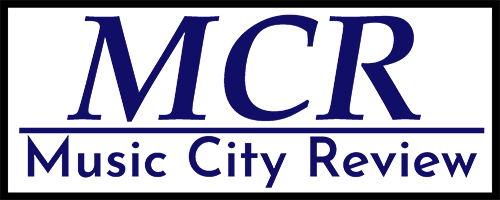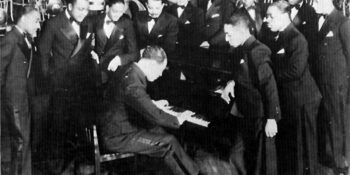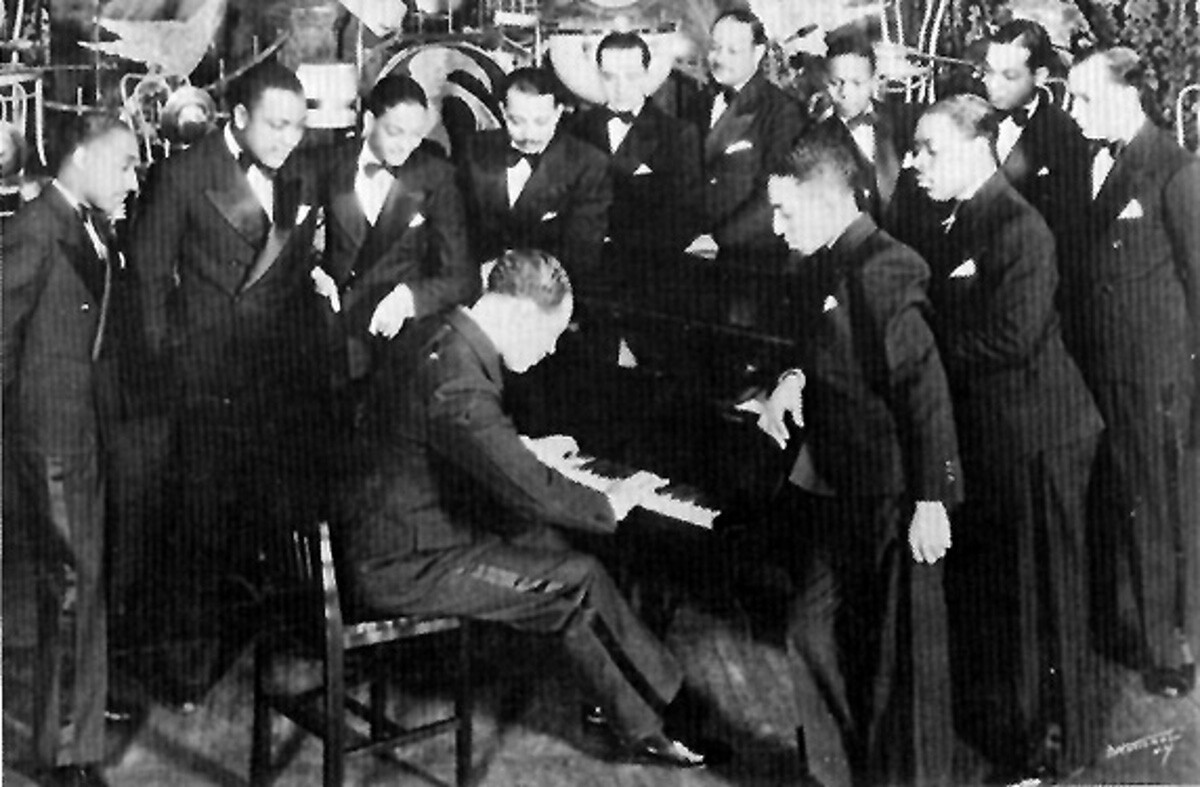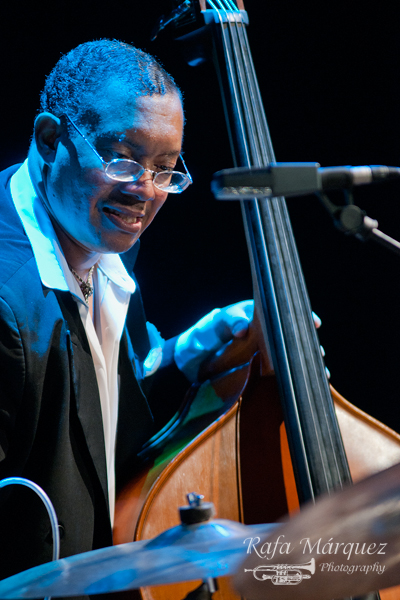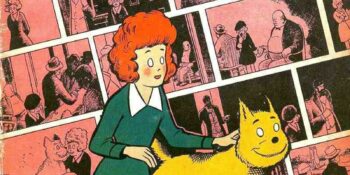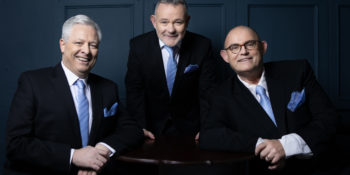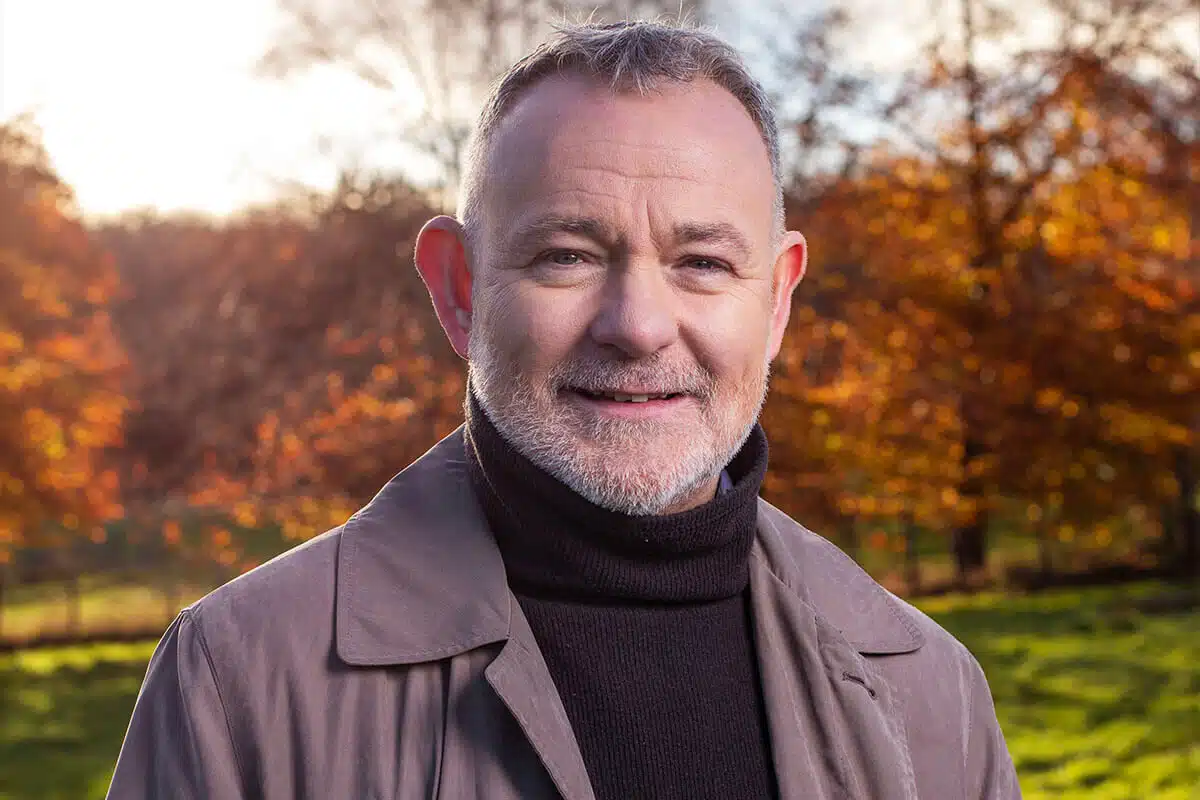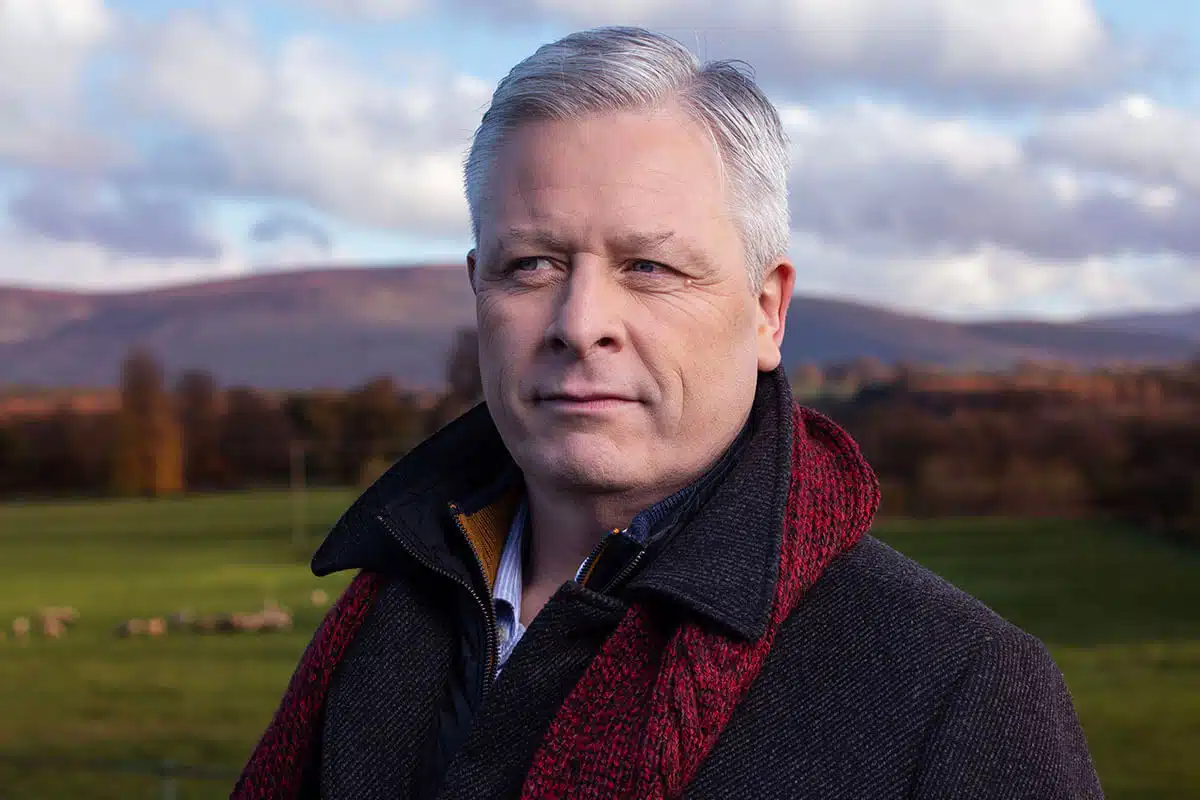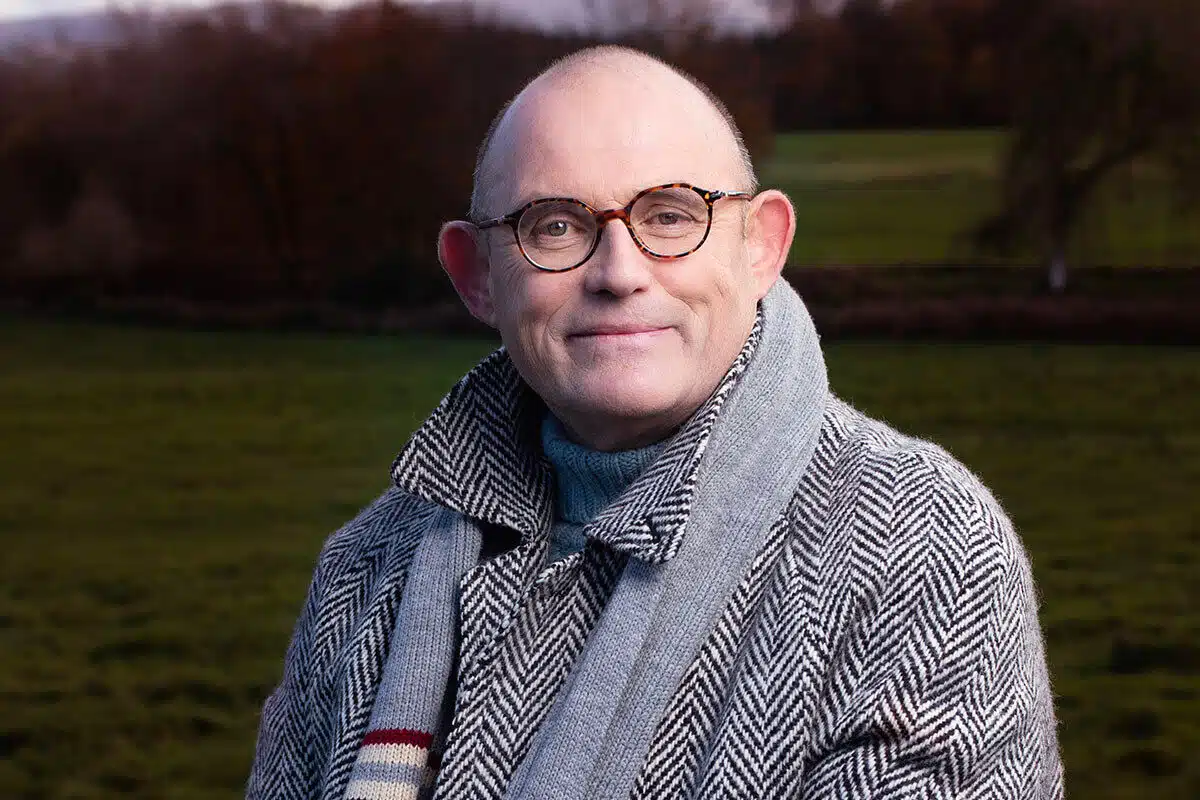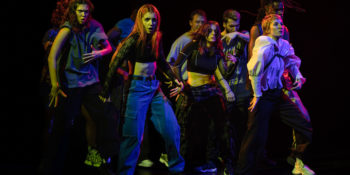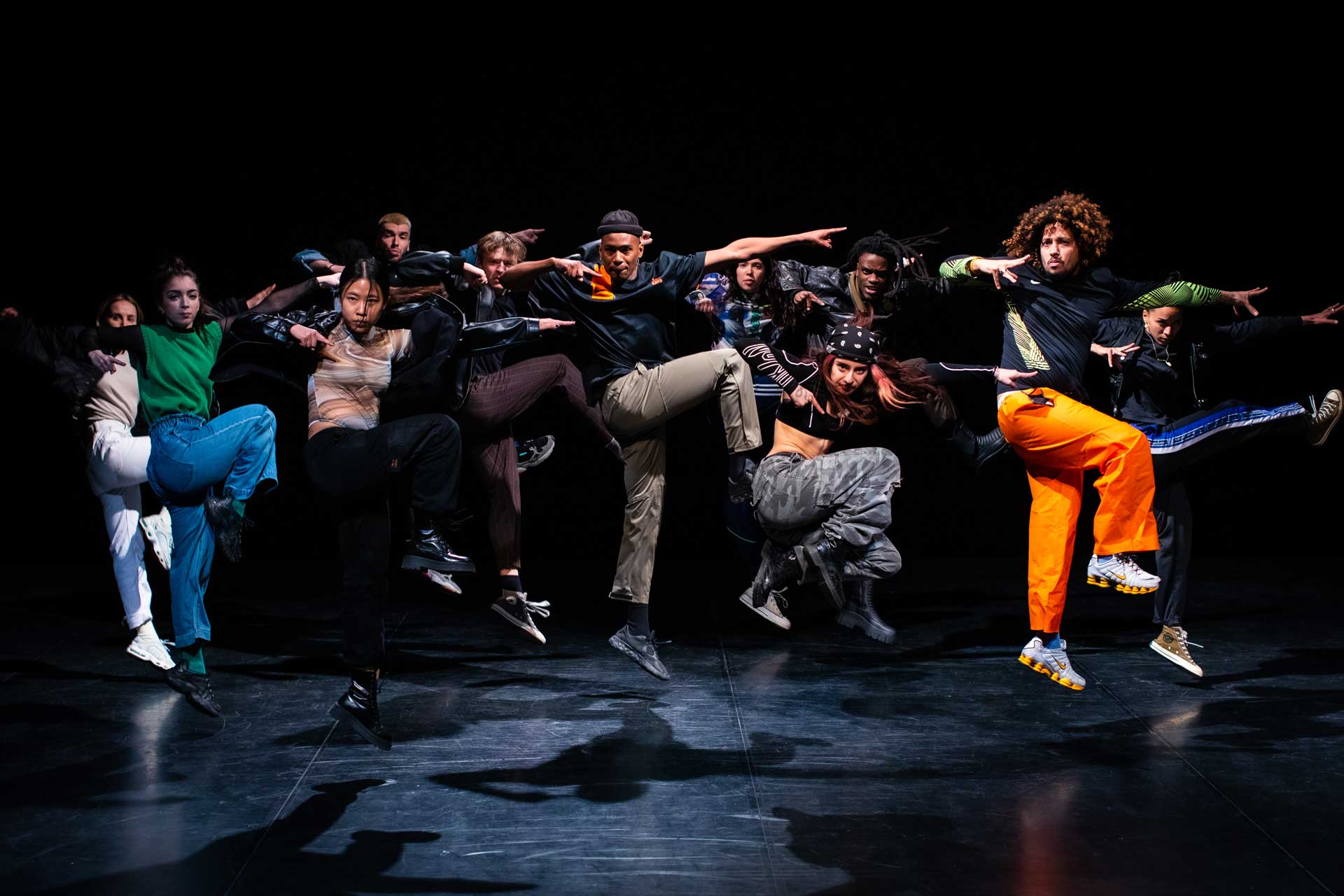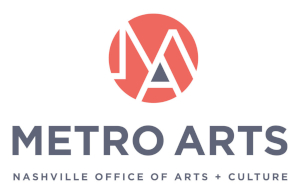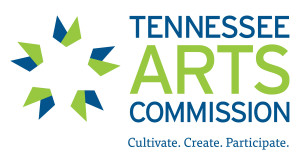Coming this Month:
The Jazz Beat: April 2024
Hello, all, and welcome back to this regular column here at Music City Review. Here, we will update you with the most can’t-miss jazz events happening in Music City, so you can be sure to catch all your favorites, as well as discover new ones along the way. Get out there and support your local musicians and keep Music City thriving! We are always looking to promote great music that may not get the attention it deserves. Have an event you think should be included in the next issue? Email me at JazzBeat@musiccityreview.com
This Month’s Highlights
Here you’ll find the shows and events this month that I think are the real standouts, unique events that you won’t find every day in the city.
Establishment Big Band w/ Guest Artist Jamey Simmons – Tuesday, April 2 – 7:30 PM (W.O. Smith Music School)
Establishment Big Band is a 21-piece band that performs big band and dance music all throughout the Mid-South region, generating scholarships for talented children to receive musical instruction as a non-profit organization. Jamey Simmons, composer, arranger, trumpeter, and educator is the special guest artist for this show. Simmons is accomplished in all of these fields, having written compositions performed by top names in jazz and teaching jazz and directing ensembles as Director of Jazz Studies at MTSU. Having dedicated his entire career to this music, this collaboration with the Establishment Big Band should no doubt prove to be a very special performance.
Come Fly With Me: A Rat Pack Rendezvous – Sunday, April 7 – 8:00 PM (Franklin Theatre)
Led by Sinatra Bar & Lounge headliner Richard Jacques, an ensemble of some of Nashville’s most talented jazz musicians will pay tribute to Sinatra and the Rat Pack, taking you through a night of Sinatra’s iconic hits, as well as classic tunes from the Great American Songbook. Along with Jacques, you’ll also be treated to the vocal talents of former Las Vegas performer Keith Sargent, and popular Nashville singers Kyle Henry and Michelle Murray. The band features some of Nashville’s top jazz talent, including Scott Ducaj, Todd Parks, Paul Winkler, and more. Tickets can be purchased through the Franklin Theatre website.
Kevin Gastonguay – Friday, April 19 – 7:30 PM (Jazz Cave)
Kevin Gastonguay has become known for his work recording and touring with Cory Wong, a jazz fusion and funk superstar. Now, in his Nashville debut, he presents his own music, seamlessly blending the classic sound of Minneapolis soul with modern funk and jazz, creating a versatile mix of genres that is easily accessible to both jazz lovers and general music audiences alike. Tickets are $35 and can be purchased through the NJW website.
Laufey – Tuesday, April 23 – 7:30 PM (Ryman Auditorium)
Jazz audiences, and lovers of jazz vocal music in particular, have an incredible opportunity this month to see Laufey at the iconic Ryman Auditorium. The young Icelandic-Chinese singer and multi-instrumentalist has made it her mission “to bring jazz and classical music to [her] generation.” It’s fair to say she has succeeded spectacularly, as she has finished sold-out tours on three continents and was the most streamed jazz artist on Spotify. Laufey has an incredible, intoxicating voice that will hold your ear all evening long. Though tickets will be difficult to get, any jazz fan should seriously consider this amazing opportunity.
Jazz Jam Presented by Nashville Women in Jazz – Tuesday, April 30 – 7:00 PM (Doors 6:30) (Sangtuary)
Though this is a regular event and not something you may expect to appear in this section, I wanted to call out this jazz jam because I think it’s an important piece of the Nashville jazz scene. Nashville Women in Jazz was created to encourage and promote women and other underrepresented people in Nashville’s jazz scene. Hosted at the Sangtuary, a non-denominational church which seeks to highlight social issues, this jam creates an open space for all types to come and celebrate the true diversity of Nashville Jazz. This event is free and open to all.
Rudy’s Jazz Room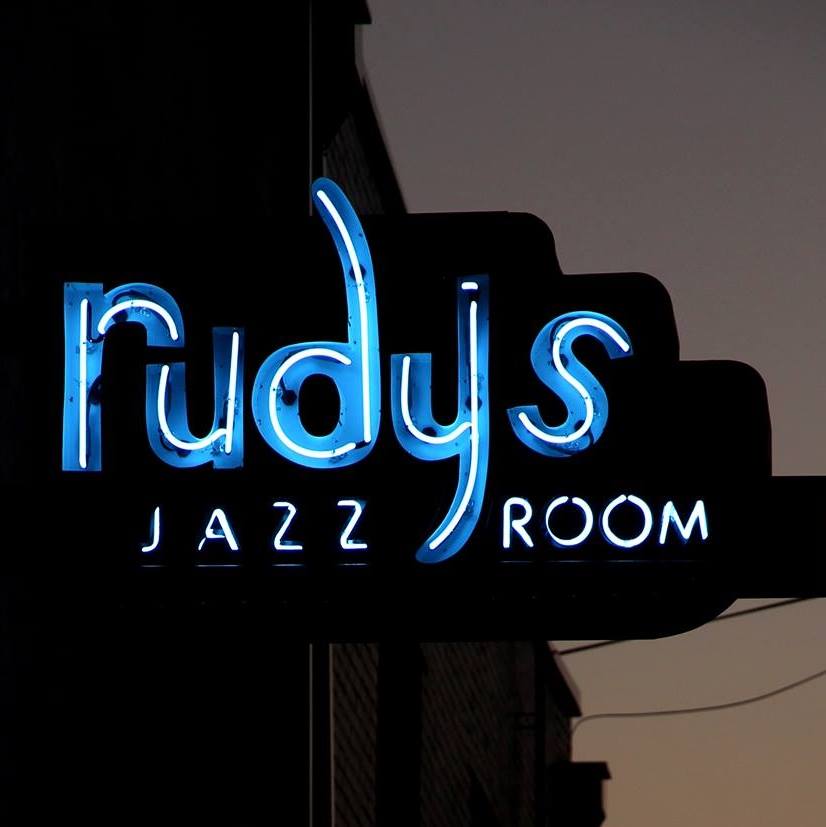
We of course must begin with Nashville’s premier jazz club, with its cozy, intimate setting. I’ll start with some of the unique highlights for this month, then follow up with the great regular acts performing. Please note that some shows are one dollar cheaper if you purchase advance tickets. I have listed the door price for all shows.
Rudy’s Highlights
Below are the performances for this month that I’ve picked out as the real can’t-miss shows, some featuring touring artists from out of state, others featuring local artists giving specialized, unique performances.
Dana Robbins Quintet – Friday, April 5 – 5:30 PM ($15)
GRAMMY-winning saxophonist Dana Robbins pays tribute to the Soul Jazz sound of the late 60’s and early 70’s, celebrating artists such as Les McCann, Eddie Harris, Jimmy Smith, and more. Robbins has either recorded or performed with many artists, including Keb’ Mo’, Aretha Franklin, Taj Mahal, Keith Urban, and more. Her band features David Santos (bass), Wes Little (drums), Phil Hughley (guitar), and Darius Mines (piano/B3 organ).
Green Box Release Party – Friday, April 5 – 8:00 PM ($22)
Three young jazz talents will present material from their recent recording projects with Green Box Music, representing three full albums. Vocalist Jireh Calo hails from Manila and is now based in Boston. Her music draws on a wide range of influences, from traditional jazz to indigenous oral traditions, creating a unique sound like no other. Jacob Jezioro, owner of Green Box Music, is also one of Nashville’s top bass talents, performing regularly with Pat Coil as well as his own bands. Evan Main is a New York City-based pianist who has studied under some of the most well-known pianists today. The performance will also feature special guests Jordan Perlson on drums and Nicholas Gold on cello.
Jeff Berlin – Friday, April 12 – 5:30 PM ($14)
Widely considered to be one of the greatest innovators of the electric bass in the world, even associated with the likes of Jaco Pastorius, Jeff Berlin performed with Bill Burford, Allan Holdsworth, and Frank Zappa, and is cited by Geddy Lee as the “the greatest bass player in the world.” His group this night features some of Nashville’s top talent, including Jacob Jezioro on bass and Bob Harsen on drums.
Ari Hoenig Trio – Saturday, April 13 (two sets) – 5:30 PM ($25) & 8:00 PM ($30)
Philadelphia-born, NYC-based drummer Ari Hoenig will stop by Rudy’s for two Saturday performances. Hoenig has been widely praised by publications such as the New York Times, Downbeat Magazine, Jazz Times, and more for his innovation as a jazz drummer, treating the instrument as equal to all the others in a group, creating a modern jazz sound. Though he has led a variety of different groups, from quartets to big bands, Hoenig now performs with the stripped-down trio, featuring Gadi Lehavi and Ben Tiberio.
Christine Parri – Thursday, April 18 – 9:00 PM ($12)
Australian-born powerhouse vocalist has been a Nashville resident since 2009, and has since made quite a name for herself as a solo artist. Her songwriting is rooted in the blues, but also features unmistakable influences from jazz, soul, and pop.
The Kelli Cox Collaborative – Friday, April 19 – 5:30 PM ($15)
Kelli Cox, one of Nashville’s most active musicians, brings back her sextet Collaborative for an evening featuring music from a wide variety of styles, so there will be sure to be something from everyone. The Collaborative features Jack Wengrosky, Greg Cox, Dan Hitchcock, Chris Autry, and Chris Brown.
Judith Owen & Her Gentleman Callers – Saturday, April 20 – 8:00 PM ($26)
Rolling Stone described Judith and Owen and her band as “an exercise in style.” In her Rudy’s performance this month, Owen celebrates the unapologetic and often unsung women heroes of 1940’s and 50’s jazz and blues music at the head of her all-star New Orleans band.
Caravan Tales – Friday, April 26 – 5:30 PM ($14)
Caravan Tales is a unique ensemble featuring some of Nashville’s top talent, embracing each member’s diverse background to form a group celebrating music from around the world. Guitarist Jerome Degey is originally from Paris and has also had a long exposure to South American culture. Multi-instrumentalist Giovanni Rodriguez was born in Italy to Dominican parents and leads several Latin ensembles in Music City. Memphis-born drummer Marcus Finnie has toured the world with countless huge acts, including Taj Mahal, Keb’ Mo’, Donna Summer, Billy Preston, to name only a few. Organist Charles Treadway is widely considered the top organist in Nashville, and has performed with some of the finest jazz musicians.
Pascal Le Boeuf’s “Ritual Being” Jazz + Classical Ensemble – Friday, April 26 – 8:00 PM ($25)
Pascal le Boeuf, GRAMMY-nominated pianist and composer presents his latest project, a 5-piece jazz/classical crossover ensemble, featuring top Nashville talent Annaliese Kowert (violin), Ian Robertson (cello), Ethan Jodziewicz (bass), and Jordan Perlson (drums).
Rudy’s Regulars
Don Aliquo Trio – Multiple Performances – Friday, April 5 – 11:00 PM & Saturday, April 27 – 11:00 PM ($10)
One of Nashville’s most active and accomplished saxophonists, Aliquo will be performing with his trio on two occasions this month.
Jody Nardone Trio – Saturday, April 6 – 5:30 PM ($16 Cover) & Saturday, April 27 – 8:00 PM ($21)
Prominent Nashville pianist Jody Nardone brings his trio to Rudy’s for a classic jazz set. With a growing national reputation, Nardone seamlessly shifts from the “whispered beauty of Bill Evans to the percussive flights of McCoy Tyner.” (Michael McCall, Nashville Scene)
Geoff Pfeifer Quartet – Friday, April 12 & Friday, April 26 – 11:00 PM ($10)
Playing a mix of Wayne Shorter tunes and originals, Geoff Pfeifer brings gritty, edgy, genuine NYC-style jazz to Rudy’s stage with his Quartet.
Stephanie Adlington – Friday, April 19 – 8:00 PM ($23 Cover)
Another frequent visitor to the Rudy’s stage, award-winning vocalist, songwriter and vocal coach Stephanie Adlington is known as the “Siren of the South,” with an “unrivaled” take on the Great American Songbook.
Sully’s Swingin’ Sunday Supper – Sunday, April 14 & Sunday, April 28 – 6:00 PM ($12)
Every other Sunday, Rudy’s features a Sunday dinner, with one of Music City’s top bassists Jimmy Sullivan leading a swingin’ jazz band featuring rotating special guests, for which a unique dinner special is served just for the show.
Re-Evolution – First Three Mondays (1, 8, 15) – 6:00 PM ($12 Cover)
This five-piece band is heavily influenced by classic jazz cutting-edge artists like Thelonius Monk, Wes Montgomery, John Coltrane, Bill Evans, and more. The band consists of Brian Cornish on saxophone, Regi Wooten on bass, Daryl Johnson on drums, Adam Charney on guitar and Alex Murphy on piano.
Pat Coil Trio w/ Special Guest Joel Frahm – Saturday, April 20 – 5:30 PM ($17)
Widely accomplished Pat Coil performs with his trio featuring Marc Widenhofer on drums and Rob Linton on bass, with special guest NYC tenor saxophonist Joel Frahm. All musicians involved are highly accomplished in their own rights, guaranteeing a stellar performance.
Regi Wooten & Friends – Every Wednesday – 9:00 PM ($15 Cover)
Coming from a distinctly talented musical family, Regi Wooten is one of the most innovative and dynamic musicians on the scene today, pushing the boundaries of the traditional genres. Equally at home playing Hendrix as Wes Montgomery, Wooten assembles a group of some of Nashville’s best musicians to offer a night steeped in funk, jazz, soul, blues and rock.
Giovanni Rodriguez & 12 Manos – Every Monday – 9:00 PM ($15)
A favorite on the Nashville Latin and jazz scene, multi-instrumentalist Giovanni Rodriguez presents an electric night of salsa, along with his band consisting of Rodriguez (bass/vocals), Melvin Macias (piano/vocals), Jesus Agreda (Timbales), Lorenzo Molina Ruiz (Trumpet), and Manuel ‘Manotas’ Ramierez (multi-Percussion).
Hot Club Gypsy Jazz – Every Thursday – 6:00 PM ($12)
Every Thursday night, Rudy’s honors its New Orleans and French roots by celebrating the vibrant music of Gypsy Jazz. These nights feature a variety of small groups either led or curated by New Orleans native Brook Sutton, all performing music in the style of the great Django Reinhardt and Stephane Grapelli. The bar will feature French Quarter-inspired cocktails as well as gumbo and beignets. Come out for as authentic a night as you can get without a trip to the French Quarter.
Rudy’s Jazz Jam – Every Sunday – 9:00 PM ($10)
I couldn’t make a list of Rudy’s events without including a shout-out for the regular weekly Jazz Jam the club hosts every Sunday night. Whether you are a jazz musician and you want to jam with your fellow artists, or you just want to come and enjoy what the local talent has to offer, the Jazz Jam is a great way to end your weekend.
The Nashville Jazz Workshop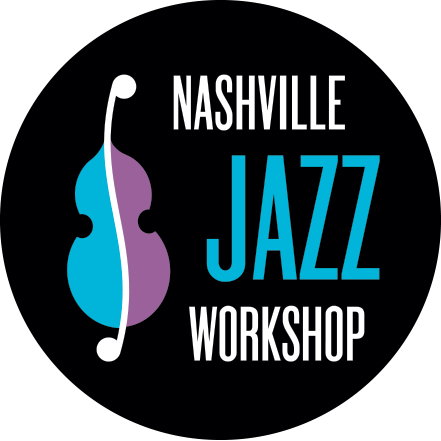
Moving on to Music City’s other great jazz venue, the Jazz Cave at the NJW is a venue with world-class acoustics, which consistently ranks in Downbeat Magazine’s list of Great Jazz Venues in the world. Tickets can be purchased through the Workshop website.
Jazz Cave
Erik Essix – WFSK Concert Series – Friday, April 5 – 7:00 PM ($35)
A new series of concerts curated by Sharon Kay, General Manager of WFSK-FM Jazzy 88 and presented by the Nashville Jazz Workshop commences with contemporary jazz guitarist Erik Essix, whose career has spanned 34 years and 28 albums. Inspired by jazz legends like Jaco Pastorius and Wes Montgomery and yet innovating for the modern era, Essix’s playing pushes the boundaries of contemporary jazz.
Alex Graham: A Tribute to Coltrane & Cannonball – Friday, April 12 – 7:30 PM ($35)
Preeminent Nashville saxophonist Alex Graham will lead a stellar ensemble to pay tribute to two of the most colossal figures in the history of jazz saxophone, John Coltrane and Cannonball Adderley. Graham will be accompanied by fellow saxophonist Dol Aliquo, and backed up by a band featuring David Rodgers (piano), Jack Aylor (bass), and Jordan Perlson (drums).
Kevin Gastonguay – Friday, April 19 – 7:30 PM (detailed above)
Ty Bailie: Tribute to Dr. Lonnie Smith and Joey DeFrancesco – Saturday, April 20 – 7:30 PM ($35)
Following the theme of paying tribute to the greats, organist Ty Bailie will pay homage to two of the greatest jazz Hammond organ masters, Dr. Lonnie Smith and Joey DeFrancesco. The Hammond organ is a rare sight at the Jazz Cave, so don’t miss this opportunity to hear the timeless, swinging music of two all-time jazz greats.
City Winery Nashville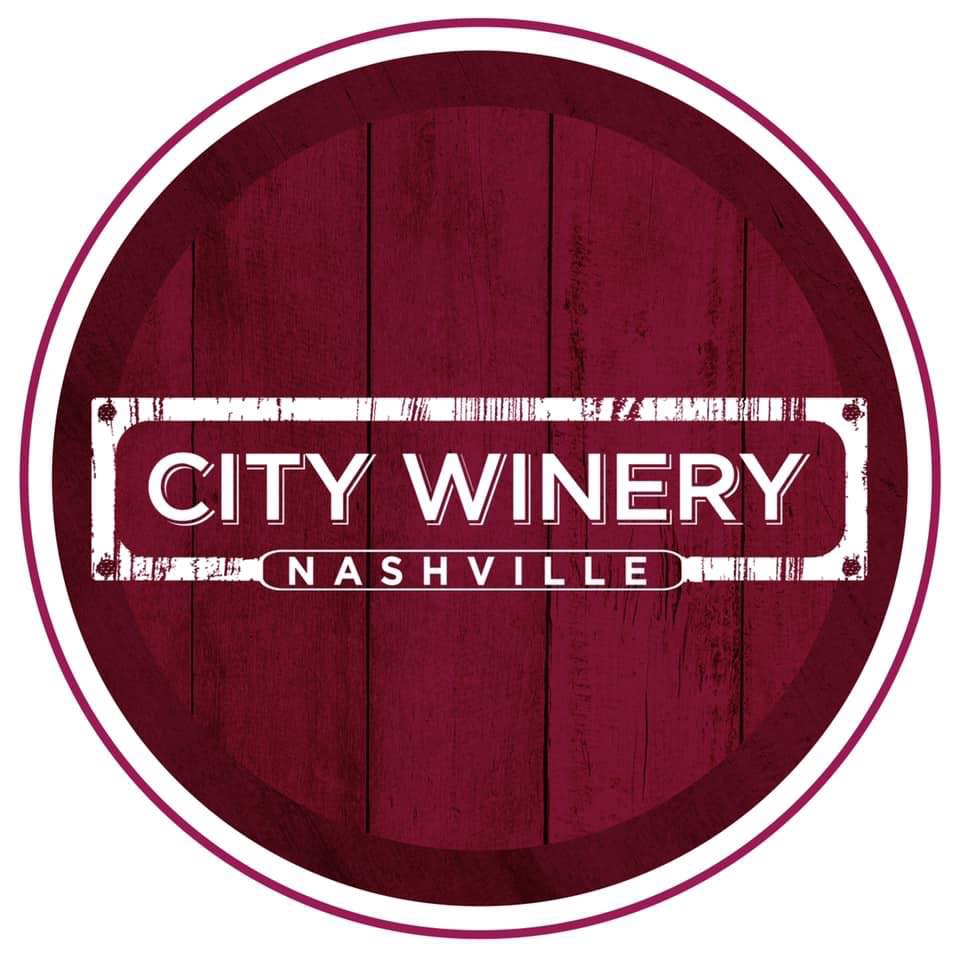
Nashville’s City Winery is a beautiful venue that consistently features top-talent acts that span genres from Jazz to Americana to Hip Hop. The below performances showcase a mix of several genres, but will certainly be of interest to any jazz audience. Enjoy these concerts accompanied by a stellar selection of wine and delicious bites.
The Lounge
Christie Lenée – Friday, April 12 – 6:00 PM ($20 advance/$25 day-of-show)
Though certainly not what I would consider jazz, Christie Lenée boasts a powerful voice and intricate guitar playing that I think would be of interest to those who love the technicality of jazz music.
Phillip-Michael Scales – Tuesday, April 23 – 6:00 PM ($17 advance/$22 day-of-show)
Having grown up close to the blues master B.B. King, a friend of his aunt, Phillip-Michael Scales initially shied away from the blues, knowing he could never equal the greatness of the legend. But over time he rediscovered it, and paired with his love of songwriting created a voice for himself in his own right.
Cheekwood Estates
Piano in the Mansion – Performances March 2, 3, 9, & 10 – 12:00-2:00 PM
On the dates above the superb and meticulously preserved Steinway piano at Cheekwood Estates will be graced by the talents of renowned and celebrated pianist Chris Walters. A New Orleans native, Walters has lived in Nashville since 1989, and in that time has enjoyed a storied career, recording and performing with a number of artists, including The Jeff Coffin Mu’tet, JD Souther, and The Peter Mayer Group. The already stunning beauty of Cheekwood Estates will be elevated even more by the soothing melodies Walters provides.
This performance is accessible with “Gardens + Mansion” tickets and Cheekwood Estates.
Other Notables
One of the things I try to do with this column is to highlight not just straight-ahead jazz but also acts that are jazz-adjacent; blues, funk, etc. because Nashville is an eclectic place filled with all kinds of music, and jazz fans are sure to be interested in other genres.
The Underdog Nashville
The Guthrie Trapp Trio – Every Monday (except April 8) – 8:00 PM ($10)
One of Nashville’s preeminent guitar talents will perform several times at the Underdog. More blues and country than jazz, Trapp’s intricate and highly technical guitar playing will surely interest those who love the technicality of jazz music. His trio features Jordan Perlson on drums and Tim Marks on bass.
The Jack Ruch Organ Trio – Every Thursday – 8:00 PM ($10)
Guitarist Jack Ruch, organist Adam Wakefield, and drummer Nioshi Jackson make up this soul and blues trio. The music you’ll hear here makes up the core of jazz’s roots, so any jazz fan should feel right at home listening to this trio.
Corey Congilio & Friends – Friday, April 26 – 8:00 PM (Free)
A well-known guitar instructor who has produced over 15 instructional courses and countless lessons for outlets such as TrueFire.com, Corey Congilio has spent the last twenty years mastering all contemporary styles, from jazz to country. Don’t miss this chance to see him perform his own music with special guests.
Arrington Vineyards
Music in the Vines Series – Every Saturday & Sunday
Starting in April, Arrington Vineyards will feature concerts of Jazz and Bluegrass every Saturday and Sunday. Acts range from Andrew Carney & the Essentials to Art Four Sale Band to the Reed Pittman Band. Saturday concerts are from 3:00-7:00 PM, and Sunday concerts are from 1:00-5:00 PM.
Sambuca Restaurant
Sambuca is a New American restaurant in the Nashville’s Gulch district, featuring nightly live music. Below are the appearances that will interest the jazz listener!
Leif Shires – Thursday, April 4 – 6:00 PM & Tuesday, April 23 – 6:00 PM
Modern jazz trumpeter Leif Shires will perform twice this month. Shires, who has performed with many artists including Tom Jones, the Secret Sisters, Kelly Lang, and many others, now presents a traditional, straight-ahead jazz sound that is sure to be a great accompaniment to a
Michael Fair – Friday, April 26 – 7:00 PM
Michael Fair is a smooth jazz artist known for the trumpet and flugelhorn. He has been performing for over 30 years, and has carved out a name for himself here in the Middle Tennessee area.
Stephanie Adlington – Saturday, April 27 – 11:30 AM
Featured above in the Rudy’s section, Adlington is an award-winning jazz vocalist.
Two Hands Restaurant
Sam Levine Trio – Every Saturday – 6:30-8:30 PM
Accomplished Nashville saxophonist and woodwind multi-instrumentalist Sam Levine performs with his trio at this Gulch café. Mel Deal on guitar, Charlie Chadwick on bass.
Nuevo de Music City
“Encanto” The Soundtrack of a Country
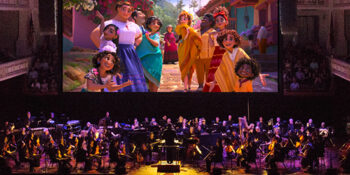
(versión en español aquí)
In cinematic consumption, animated films are generally appreciated as children’s entertainment and soundtracks as background music. The truth is, that both animators and composers in cinema elevate artistic creation by adhering to the meticulous representation of movements that our brains take for granted. The moment a gesture and a sound are not authentic, the audience disconnects from the scene. Beyond the ‘cartoons’ and catchy songs, Encanto honors the child audience and a nation. I have had to watch this movie each time with a different purpose: to appreciate its plot, to identify the folkloric and scenic elements, and to immerse myself in its music. I never imagined that this latter aspect would materialize in an auditorium with an orchestra.
On March 16th and 17th, the Schermerhorn transformed into the “Casita” that would host families and fans donning costumes of the movie characters. Expectations soared as conductor Anthony Parnther introduced the show in a velvety voice as if he were part of the production dubbing. Parnther and some members of the Nashville Orchestra participated in the original recording of the soundtrack. This singular event only heightened the desire to once again immerse oneself in the film’s fantasy but with the music played live!
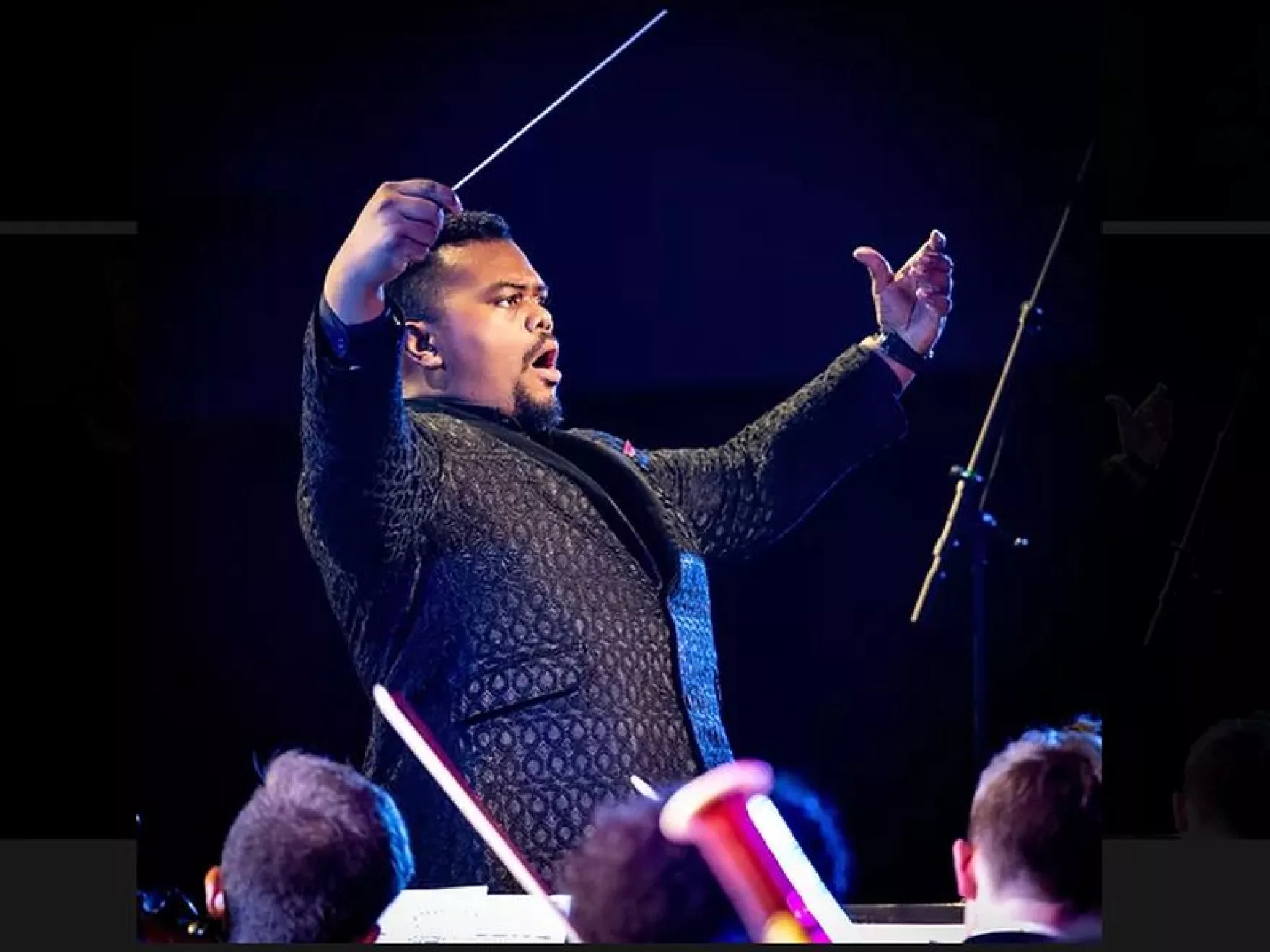
www.anthonyparnther.com)
The story of Encanto is inspired by the literary movement of magical realism; merely the juxtaposition of these two concepts makes its meaning difficult to put into words. The simplest example I find to define this style is the character of Julieta who “the truth is she can heal you with a meal, her recipes are remedies for real.” A mother’s unmistakable seasoning has the power to lift our spirits and energy when we are unwell. That’s reality, but that “superpower” makes it magical. Germain Franco’s feat was to turn this meaning into sound—how to link the everyday and fiction in incidental music. Unlike the production team and composer Lin Manuel Miranda, who traveled to El País de la Belleza (Colombia) to document its multiculturalism and diversity, Franco received the proposal to compose the soundtrack amid the pandemic.
The sound richness of Antonio’s Voice is evidence of the composer’s deference to Colombian folklore. The Pacific Coast of the country is a territory barely explored when it comes to biodiversity and Latin American culture. In this region where the jungle meets the sea, the Afro-Colombian race resonates through female voices and the marimba de chonta. For this piece, Franco commissioned the instrument from a local luthier and played it herself in the recording. She managed to gather a choir of “cantadoras” (female singers) and directed the sessions from a Zoom window. The result is mind-blowing; the orchestra transports the rhythms of bullerengue across the waters of the Atlantic to the jungle that separates them from the Pacific waters. The choir announces Antonio’s arrival in a frenzy that becomes increasingly uncontrollable to the senses. When the high register of the voices merges with the symphonic timbre, the enchantment of orchestration in soundtracks becomes tangible. If the piece alone is a breathtaking experience, accompanied by a scene that extraordinarily represents Colombian megadiversity, it becomes a true work of art.
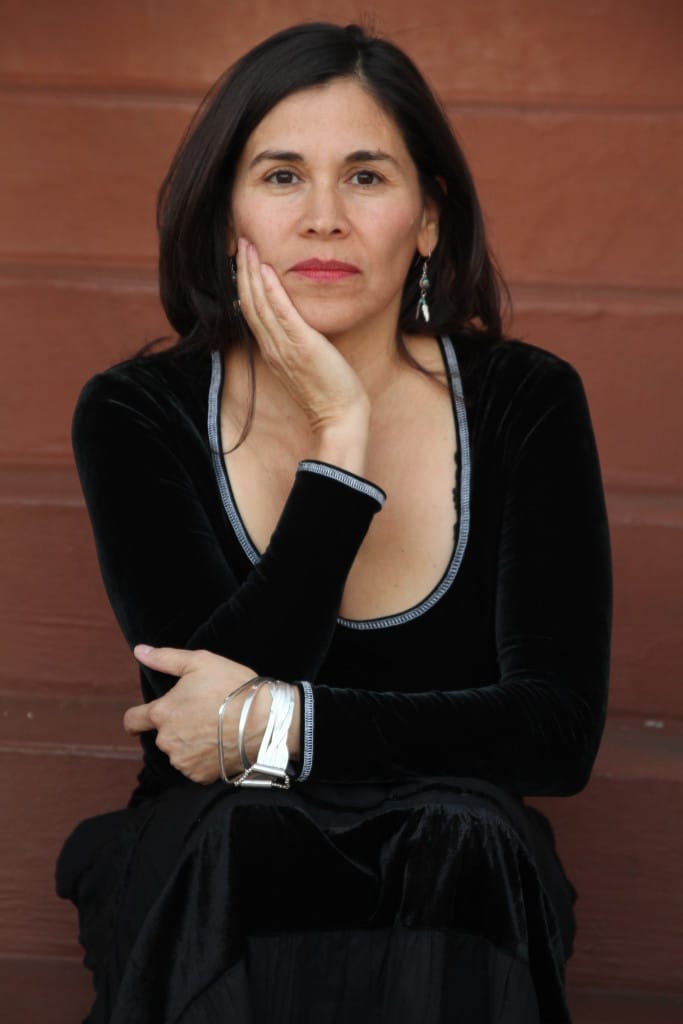
One of the qualities that immediately caught my ears the first time I heard the Nashville Symphony Orchestra was the transparency and balance in the sound of the strings. This particularity is essential in film music; in multiple sequences, a chord is extended extensively, supporting the movement of the other voices or serving as a transition in the plot. It is common to use digital effects in the production of soundtracks to enhance the intention or atmosphere of a scene. However, aspects such as dynamics and tuning sympathy were masterfully achieved by the orchestra as if it were a recording. To create a three-dimensional effect of sound, there were sections where only some members of each section played the melody. For example, in certain parts, the last violin desks were the only ones subtly coloring the percussion bases.
Colombia’s geographical position and the convergence of multiple races make it a country with an extraordinary variety of cultures. Regarding music, its wide range of instruments defines the timbral nature of each region. Franco and Miranda faced a plethora of possibilities to enrich their composition and make it even more genuine. Instruments like the bandola, tiple, and cuatro (strings), cununos and maracón (percussion), and caña de millo and gaita (winds) were showcased by Colombian performers during the recording. In this concert, they were replaced by instruments with similar characteristics; the stage was filled with guitars and drums playing to the rhythms of bambuco and cumbia. Yes, Colombian cumbia.
It is admirable both in the composition of incidental music and the performance without cuts to chronometrically adjust to each scene. The melodies and effects not only accompany an emotion but also reaffirm the sound design of the movie; therefore, they must be played with precision. Parnther is an expert in assembling soundtracks as a conductor and bassoonist thanks to his extensive experience in the film industry. The Nashville Symphony Orchestra seems to be mastering this terrain as well, with its attractive selection of films included in its seasons. The audience has come to appreciate these concerts, describing them as an experience on another level, and as a result, they ensure to secure their seats well in advance.
Nuevo de Music City
“Encanto” La Banda Sonora de un País

(English Version here)
En el consumo cinematográfico las películas de animación son generalmente apreciadas como entretenimiento infantil y las bandas sonoras como la música que suena detrás. Lo cierto es, que tanto animadores como compositores en el cine, elevan la creación artística al ajustarse a la meticulosa representación de los movimientos que nuestro cerebro da por hecho. En el momento en que un gesto y un sonido no sean auténticos, el público se desconecta de la escena. Mas allá de los ‘dibujitos’ y las canciones pegajosas, Encanto honra a la audiencia infantil y a una nación. Esta película he tenido que verla cada vez con una intención diferente; la de apreciar su trama, la de identificar los elementos folklóricos y paisajísticos, y la de abstraerme con su música. Nunca imaginé que esta última se materializara en un auditorio con la orquesta en disposición.
Los días 16 y 17 de marzo, el Schermerhorn se transformó en la “Casita” que acogería a familias y aficionados luciendo los trajes de los personajes de la película. Las expectativas aumentaron cuando el director Anthony Parnther introduce el espectáculo en una aterciopelada voz como si hiciera parte del doblaje de la producción. Parnther y algunos miembros de la Orquesta de Nashville estuvieron presentes en la grabación original de la banda sonora. Este solo acontecimiento acrecentó las ansias de envolverse de nuevo en la fantasía del filme, pero con la música ¡en vivo!

www.anthonyparnther.com)
La historia de Encanto está inspirada en la corriente literaria del realismo mágico; tan solo la oposición de estos dos conceptos, hace que su significado sea difícil de poner en palabras. El ejemplo más sencillo que encuentro para definir este estilo, es el personaje de Julieta que “con su comida cura todo mal, sus guisos son remedios de verdad.” La inconfundible sazón de una mamá tiene el poder de levantarnos el ánimo y la energía cuando estamos indispuestos. Esa es la realidad, pero ese “super poder” la hace mágica. La proeza de Germain Franco fue convertir este significado en sonido, ¿cómo enlazar la cotidianidad y la ficción en la música incidental? A diferencia del equipo de producción y del compositor Lin Manuel Miranda que viajaron al país de la belleza para documentarse de su multiculturalidad y diversidad, a Franco le llegó la propuesta de componer la banda sonora en medio de la pandemia.
La riqueza sonora de Antonio’s Voice es la prueba de la deferencia que tuvo la compositora con el folklore colombiano. La Costa Pacífica del país es un territorio vagamente explorado cuando se hace referencia a la biodiversidad y a la cultura latinoamericana. En esta región donde se combinan la selva con el mar, la raza afrocolombiana resuena a través de las voces femeninas y la marimba de chonta. Para esta pieza, Franco encargó el instrumento a un luthier de la zona y ella misma lo interpretó en la grabación. Logró reunir a un coro de mujeres “cantadoras” y dirigió las sesiones desde una ventana de Zoom. El resultado es alucinante; la orquesta se encarga de trasladar por las aguas del Atlántico los ritmos del bullerengue a la jungla que las separa de las aguas del Pacífico. El coro anuncia la llegada de Antonio en un frenesí que se hace cada vez más incontenible en los sentidos. Cuando el registro agudo de las voces se mimetiza en el timbre sinfónico, se hace tangible el encantamiento de la orquestación en las bandas sonoras. Si la tan sola pieza es una experiencia sobrecogedora, acompañada de una escena que representa extraordinariamente la megadiversidad colombiana, se convierte en una verdadera obra de arte.

Una de las cualidades que saltó a mis oídos la primera vez que escuché a la Sinfónica de Nashville, fue la transparencia y el balance en el sonido de las cuerdas. Esta particularidad es imprescindible en la música para cine; en múltiples secuencias un acorde se prolonga extensamente soportando el movimiento de las demás voces o sirviendo de transición en la trama. Es usual utilizar efectos digitales en la producción de las bandas sonoras para potenciar la intención o la atmósfera de una escena. Sin embargo, aspectos como el dominio de matices y la simpatía en la afinación fueron magistralmente conseguidos por la orquesta como si se tratara de una grabación. Para fabricar un efecto tridimensional del sonido, hubo secciones en que solo algunos miembros de cada fila interpretaban la melodía. Por ejemplo, en determinadas partes los últimos atriles de los violines eran los únicos que coloreaban con sutileza las bases de la percusión.
La posición geográfica y la convergencia de múltiples razas hacen de Colombia un país con una extraordinaria variedad de culturas. En referencia a la música, su amplia organología define la naturaleza tímbrica de cada región. Franco y Miranda tuvieron en frente un abanico de posibilidades para enriquecer su composición y hacerla aún más genuina. La bandola, el tiple y el cuatro (cuerdas), los cununos y el maracón (percusión), la caña de millo y la gaita (vientos) hicieron gala en manos de intérpretes colombianos para la grabación. En este concierto se reemplazaron por instrumentos homónimos; el escenario rebosaba de guitarras y tambores al ritmo del bambuco y la cumbia. Sí, la cumbia colombiana.
Es admirable tanto en la composición de música incidental como su interpretación sin cortes, el ajustarse cronométricamente a cada escena. Las melodías y los efectos no solo acompañan una emoción, sino que reafirman el diseño sonoro por lo tanto deben ser ejecutados con precisión. Parnther es experto en el montaje de bandas sonoras como director y fagotista gracias a su amplia experiencia en la industria cinematográfica. La Sinfónica de Nashville parece estar dominando también este terreno con la atractiva selección de filmes que ha incluido en sus temporadas. El público ha sabido apreciar estos conciertos calificándolos como una experiencia de otro nivel, en consecuencia, separan sus sillas con suficiente anticipación.
Beetlejuice: The Musical Is Better Than The Movie
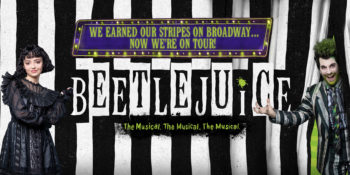
On tour since 2022, Beetlejuice: The Musical is at TPAC March 12-17, and sold out almost every performance. I attended opening night, and despite the half-hour interruption due to some electrical problem that occurred twenty minutes into the performance, had a marvelous time. I’d never seen Andrew Jackson Hall that full, or the audience that enthusiastically engaged. I didn’t hear any grumbling during the unexpected delay; rather people seemed to find it a good opportunity to buy more concessions and merchandise, or squeeze in a trip to the bathroom.
The musical adaptation of the 1988 film is, in my possibly heretical opinion, much better. It isn’t afraid to shift some major story elements: the Maitlands, the nice couple who die at the beginning of the story, play a much more minor role, and Lydia (played by young Winona Ryder in the film) is made into a much more sympathetic character. Instead of simply being strange and morbid, she is struggling through grief at her mother’s death and her father’s seeming emotionlessness. Instead of focusing on the Maitlands’ struggle to figure out the afterlife, the musical has Beetlejuice burn their Handbook for the Afterlife before they awake as ghosts. In this, the conflict of the story is between Beetlejuice’s desire to join the world of the living and Lydia’s desire to reach her dead mother.

The musical begins with Lydia’s lovely and sincere ballad at her mother’s funeral. As it ends, Beetlejuice says, “Holy crap, a ballad already? And such a bold departure from the original source material,” then begins his song, “Welcome to a Show About Death.” The contrast between Beetlejuice and Lydia continues throughout the musical, balancing what many postmodern stories can’t seem to figure out: how to be vulnerable, sincere, and funny at the same time. Here, Lydia is focused on her loss and then, later in the story, on finding her mother in the Netherworld. Beetlejuice is that ridiculous sort of amoral agent of chaos, who is bad, crass, and disgusting but who is enjoying himself so thoroughly that you can’t help but enjoy him. Meta-humor is quite prevalent, especially at the beginning, with Beetlejuice setting up the story for the audience and yelling at people in the crowd. The self-referential humor isn’t overdone, and really fits in well with the material and the music theater setting. Having someone on stage occasionally give a flippant tweak to the fibers of the audience’s interconnected imagination is quite fun.
Like the film, the musical is frequently crass and there are plenty of sexual jokes that make it definitely not for children. I have seen comments online saying that the musical is too crude, which I find somewhat surprising: the original film has always been crude. The audience the night I attended was mainly adults, and if any of the parents who did bring children to the show were unpleasantly surprised, well, the show has a content advisory.
The story is weighted toward Beetlejuice’s personality, and the only character that can combat that is Lydia. The Maitlands have been changed from an comically idyllic couple into lame repressed millennials panicking about whether they should follow through on their original plan to have a baby, then accidentally electrocute themselves. The joke that they’re lame went for a little too long, so I didn’t really care about their plot points or character growth besides the fact that they helped Lydia. Delia, the life coach hired by Lydia’s dad to help her through her grief, is a ridiculous character mocking all the current “spiritual” pretensions, and leading to a funny song between her and Lydia, letting their conflicting philosophies battle, the dual extremes of believing in nothing and believing in everything.
The second act of the musical is different than that of the film, Lydia learning to value life, let go of her mother, and come to an understanding with her father. Even Beetlejuice has a brief moment of goodness, although don’t worry, he doesn’t suddenly turn into a good person. Both the musical and film share the same ending, of singing more Harry Belafonte as an unorthodox but happy family.
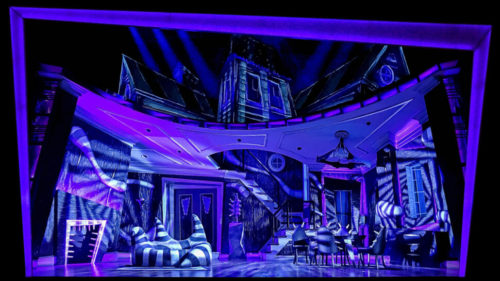
The sets, lighting, and practical effects are absolutely fantastic. They are over-the-top and Burtonesque, vibrant and active. The set changes frequently, the Maitlands’ house askew and at odd angles, like a more consumer-friendly, funhouse version of sets from The Cabinet of Dr. Caligari. The lighting accentuates all the moments of ghostly magic, sometimes even blasting the audience with such bright flashes of light the stage becomes unseeable, allowing actors to leave the stage in their comparative darkness. The green glowing light of the doorway to the Netherworld is particularly well done. There are many practical effects, too: Beetlejuice tosses fire, removes and shifts limbs, hands appear out of platters or snakes from heads, a giant sand worm appears, and so on. In a world inundated with CGI and easy digital editing, it’s refreshing to be surprised and impressed, to wonder “how they did do that” before being pulled back into the story.
The music itself is great, Eddie Perfect’s lyrics being particularly funny, and they’re full of plot and dialogue, propelling the story forward. His adaptation of “Day-O (The Banana Boat Song)” and “Jump in the Line ” are fun and more than simple covers. I’d wondered going in if the music was going to be 80’s themed as part of a nostalgia-grab, but it isn’t. It uses the ensemble well and blends different musical elements to match the content: some dies irae, classic and modern Broadway sound, a little pop, and circusy and Elfman vibes.

Justin Collette as Beetlejuice is wonderful, his gleeful horribleness fun to watch and energizing the entire play. His gravely tone and strong voice work well and his comic timing is fantastic. If every other actor was a dud, he would still manage to make the show work. Luckily, that isn’t the case, and Isabella Esler is an excellent Lydia: sad but not whiny, strong but not unkind, with a sense of humor and a strong voice. To add to her perfect casting, she’s petite and all the adults characters tower over her emphatically. The ensemble gives strong choral moments and acrobatic dancing, especially during the song “That Beautiful Sound” when Beetlejuice dances with many doppelgängers of himself.
I recommend seeing the show: if you never were a Tim Burton fan, this musical tones down some of the grimy ghoulishness of the film, and if you are a big fan, it’s got even more theatrical vigor than the movie. The run at TPAC is almost over, but the show will be in Georgia, Kentucky, and even Tennessee again in the coming months, so if you’re interested see https://beetlejuicebroadway.com/.
The MCR Interview
Director Stephanie Dillard on the staging of Lauren Gunderson’s acclaimed play The Revolutionists and Women in Theater (WIT) Nashville
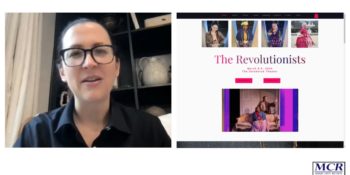
Stephanie Dillard is an opera-singer, audiobook narrator, theater director and the board president of Women in Theatre (WIT) Nashville which was founded in 2023 to showcase the incredible talent, stories, and voices of women in the performing arts. On March 8th and 9th, starting at 7:30pm, at the Darkhorse Theater, Women in Theater (WIT) Nashville showcases its first premiere with Lauren Gunderson’s acclaimed play The Revolutionists.
From the Street Theatre Company
Nashville’s Trail to Oregon!
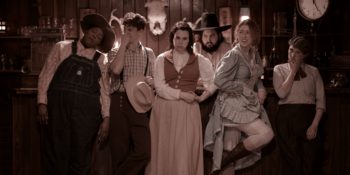
Before I can get to the performance by Nashville’s Street Theatre Company, we must first discuss the subject of the parody, and the creators of this musical. First, The Oregon Trail games are much older than I had realized; in my solipsism, I’d assumed the game started and ended on CD in the 1990’s, but it originated as a game for kids in 1971 (on the HP 2100 minicomputer, which used teletype instead of a screen), and I can download the latest version to my phone today. 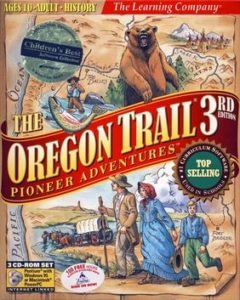 The point of the game is to teach children how difficult the Oregon Trail was for its travelers. Different versions of the game differ, but after choosing the supplies for the journey and making tough choices on the trail, players meet with many misfortunes (unexpected or due to poor judgment) as they try to reach their goal. Death occurs frequently. Growing up, we never owned the game, but one of our friends did. It’s rather a meme now, and I’ve played the board game adaptation with friends and had a good time.
The point of the game is to teach children how difficult the Oregon Trail was for its travelers. Different versions of the game differ, but after choosing the supplies for the journey and making tough choices on the trail, players meet with many misfortunes (unexpected or due to poor judgment) as they try to reach their goal. Death occurs frequently. Growing up, we never owned the game, but one of our friends did. It’s rather a meme now, and I’ve played the board game adaptation with friends and had a good time.
StarKid Productions (also known as Team StarKid) started at the University of Michigan in 2009, when their YouTube post of A Very Potter Musical went viral. Since then they’ve produced 13 musicals (parodies and originals), have featured in the top 10 on Billboard charts, and have gained hundreds of millions of views. My introduction to them was through a group chat on a Monday morning, when someone posted this clip: https://www.youtube.com/watch?v=B2EI65ZEqYQ, from their musical Firebringer. In 2014, StarKid Productions created a musical parody of The Oregon Trail, called Trail to Oregon! which is available to view on YouTube: The Trail to Oregon!. After seeing the Street Theatre performance I watched and compared different sections of the musical with the original video, and I have to say I think the Nashville performance is funnier and reflects the original game better. I may be biased because I saw it first, but I think they added more humor. In one deliberately heartless scene, the son kills a family of buffaloes. The lisping baby buffalo can’t walk very well, and in Street Theatre’s production the actor Elijah Wallace adds a new layer chaotic humor by making the baby buffalo’s babytalk ridiculously sensual. Besides additional jokes, I mainly prefer this cast’s interpretations of the characters, too: they’re all a little kinder to each other, a little more equal in their goofiness. Street Theatre didn’t simply mimic the popular video of the play, they performed their own quality interpretation.
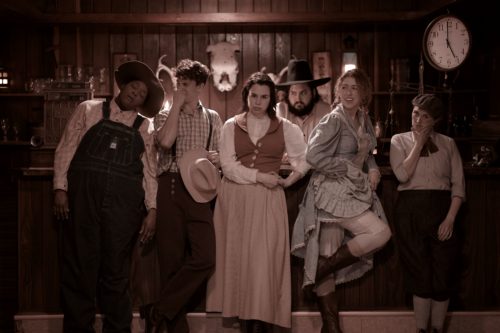
Trail to Oregon! follows a family: Father, Mother, Grandpa, Daughter, and Son, all of whom the audience names at the beginning of the performance. Besides being fun at the time, each name is an opportunity for additional humor later on: the line, “That’s my son, [son’s name], the baby killer,” was made into a punchline after the audience named him “Plan B.” The family buys supplies, meets a bandit, and begins their journey, meeting the challenges of environment, equipment, hunting (there’s the excellent line from Grandpa as he takes the kids out to hunt: “You shot me, that means your turn’s over.”), snakebites, kidnappings, and more. Since the musical is a parody, it doesn’t have a tight plotline, but focuses more on joking about the familiar elements of the game. This show is about being silly, and it does that very well. The only time that it gets to be too much is for a moment at the end, when the character the audience voted for dies of dysentery, and their dying song is accompanied by the sounds of viscerally unpleasant flatulence for far too long.
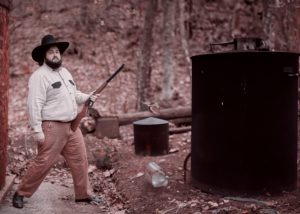
The acting is great, and so is the singing. Benjamin Frieson makes the ridiculously optimistic father charming, and Jennifer Whitcomb-Oliva makes the bandit’s sidekick disproportionately funny in relation to how many lines the character has. My favorite is Elijah Wallace, who plays the greatest variety of roles, from the baby buffalo to the villainous bandit. Eve Petty plays the daughter, whose teenage sensuality is especially well done, balancing naivete with readiness.
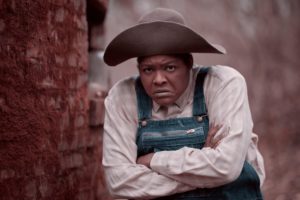
The set does an excellent job of showing the video game inspiration: the backdrop is painted into a pixilated backdrop of scenery from the Oregon Trail, and six large wooden boxes are moved around the stage to create the furnishings, as well as housing items under their lids, and the puppets used to perform the buffalo parents are a great touch.
This was my first experience with the Street Theatre Company. They perform at the Barbershop Theater, which is a small building off a gentrifying street not too far from the Darkhorse Theater. Street parking is readily available and the building is quite simple: step in through the front door and you’re in the black box theater, the diagonal of the stage pointing at you, and rows of well-cushioned seats are available along both sides of the diagonal, seating about 40 people. A small concession stand is right by the entrance, and the only downside of the space is that it has one single-stall bathroom, and during intermission the actors have it for a portion of the time. Hydrate accordingly. Due to limited space, the live band is in a building behind the theater and they pipe in and mix the sound. I thought they performed to a mysteriously good recording until Taryn Pray (the Son, “Plan B”) explained how they managed it.
I would tell you to buy tickets for this show, except I can’t: it’s entirely sold out. Street Theatre Company’s final show of the season will be Fun Home in June, and next season’s shows are already announced: https://www.streettheatrecompany.org/23-24-season.
